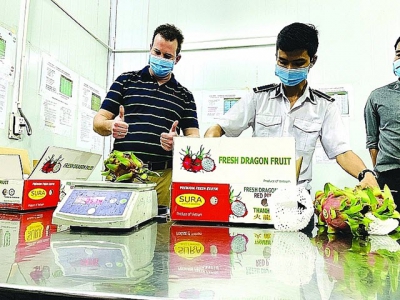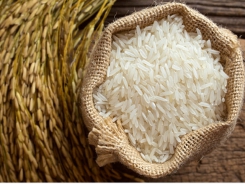Export of agricultural products: Competitive advantage belongs to well-invested enterprises

The concept of an easy market will be removed when all join the same community and are committed to commercial agreements with the same standards. Accordingly, methodical investment to bring high quality and stability for products is the only way for businesses to sell their products in the global market.
American irradiation specialists and plant quarantine officers inspect exported fruit products at Son Son Irradiation Center. Photo: N. Hien
One standard for all markets
As a member of 15 FTAs, especially the new FTAs such as the CPTPP, EVFTA, RCEP and UKVFTA, almost all of Vietnam's export markets are covered in agreements with a wide range of requirements on origin, quality standards and food safety and hygiene.
Nguyen Dinh Tung, General Director of Vina T&T Group, said Japanese, Korean and Australian markets had been classified as difficult markets in the past, while ASEAN and China had been easy markets. However, with the newly signed RCEP agreement, all are in the same position.
"There are no easy markets for Vietnamese agricultural products, all must meet strict quality standards and traceability," said Tung.
Dang Phuc Nguyen, General Secretary of the Fruit and Vegetable Association, said the Chinese side was preparing procedures to require enterprises exporting Vietnamese agricultural products to attach QR codes when exporting goods to this market.
Chinese Customs will scan the QR code to check information on the goods origin, planting area codes, and quality standards before customs clearance. This requirement has also been applied to Thai agricultural exporters since 2019 to limit the situation of "borrowing" the planting area code, and fraud of origin of goods.
Accordingly, this requirement will make it more difficult for Vietnamese enterprises to export to this market, especially those firms that are not familiar with the e-commerce environment such as e-stamp, and traceability for their commodity. Because there are not many agricultural enterprises interested in traceability stamping.
Opportunities for business with methodical investment
The strict requirements from the markets of the FTAs pose many challenges for Vietnamese agricultural products. However, for businesses that have conducted methodical investment, this is a huge opportunity to expand their market. In the Chinese market, for instance, large enterprises faced many difficulties when competing for low-priced and unofficial quota goods. Therefore, Thon said RCEP would help the official exports to China develop and this was an opportunity for large enterprises with high quality products.
Tung also said in the future, exports to the Chinese market would be promoted and he was fully confident in his success because Vina T&T's products have affirmed their reputation for quality in the world's most fastidious markets such as the US, the EU, Japan, and Australia.
Enterprises assessed that in the future, the competition would be more fair and agricultural export activities would focus on enterprises with a good foundation. Thus, weak units will have no more opportunities due to improved market requirements. Firms with good quality products will better promote Vietnamese agricultural products, thereby attracting more farmers to cooperate, expanding cultivation areas and producing quality products with higher output.
However, opportunities are not completely closed for small firms whose products have not met the requirements of the import market. The RCEP in particular as well as the FTAs in general are opportunities and motivations for businesses to improve product quality, complete supply chains, and improve their own competitiveness. By doing that, businesses will gain many benefits such as higher selling prices, better and more sustainable profits.
To achieve this, Thon said production chains need to be upgraded into an ecosystem to gather all the elements involved in the process of products, from production to export. This will maximize the social resources, remove unnecessary conflicts of small producers and businesses, thereby reducing costs and improving the competitiveness of agricultural products.
Another opportunity from the RCEP, according to Nguyen, is the negotiation to open export markets for many Vietnamese agricultural products. Vietnamese fruits and vegetables will become more favourable than before thanks to commitments to open markets for goods, services, investment, value rules of origin in the RCEP geographic area and trade facilitation measures of member countries.
For example, the Chinese market welcomed only 10 types of fresh fruits and vegetables from Vietnam, and the same is true for other markets such as Japan, Korea, Australia, Thailand and New Zealand. In the future, it is forecasted that the negotiation to add new fruits and vegetables will be faster and easier. Therefore, the country must prepare raw material areas to meet the market requirements of quality and output.
Huynh Van Thon, Chairman of the Board of Directors of Loc Troi Group JSC:
Rice exports will increase both in volume and price
In addition to the objective factors caused by the Covid-19 pandemic, the improvement of varieties and production has raised the competitiveness of Vietnamese rice. In particular, Vietnam has a lot of experience in negotiation, which has resulted in higher export rice prices in recent years. In 2021, the pandemic will probably be better controlled, along with the knowledge, available production capacity and new developments in rice prices due to changes in supply and demand, rice exports in 2021 are forecasted to have good prospects in terms of both volume and price. To meet this expectation, Vietnamese firms need to avoid competing with each other to devalue themselves, which can be a painful experience.
Có thể bạn quan tâm
Phần mềm

Phối trộn thức ăn chăn nuôi

Pha dung dịch thủy canh

Định mức cho tôm ăn

Phối trộn phân bón NPK

Xác định tỷ lệ tôm sống

Chuyển đổi đơn vị phân bón

Xác định công suất sục khí

Chuyển đổi đơn vị tôm

Tính diện tích nhà kính

Tính thể tích ao hồ



 Vietnam Jan coffee exports drop 17.6%, rice down…
Vietnam Jan coffee exports drop 17.6%, rice down…  Vietnam agro-forestry-fisheries exports to reach US$50 billion revenue…
Vietnam agro-forestry-fisheries exports to reach US$50 billion revenue…